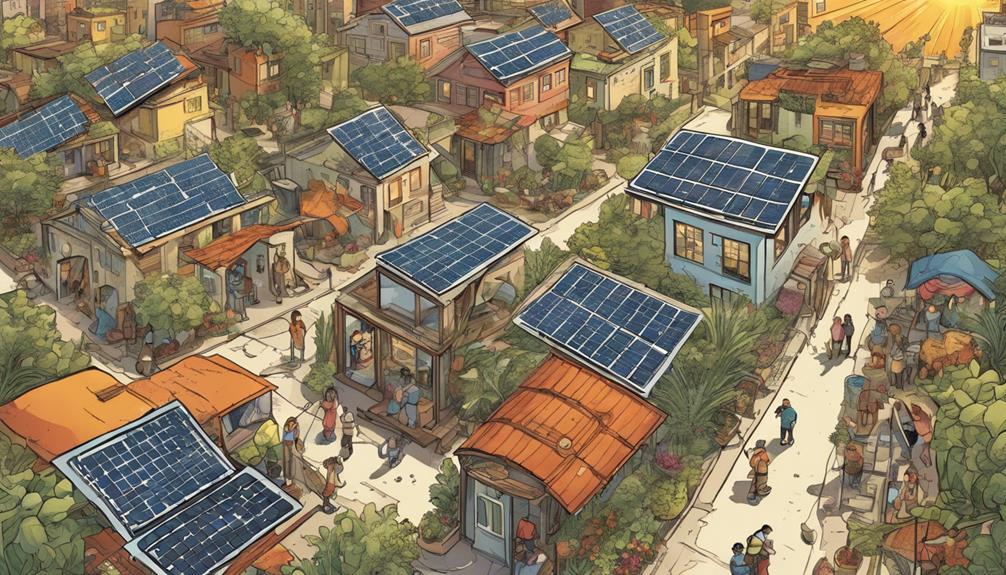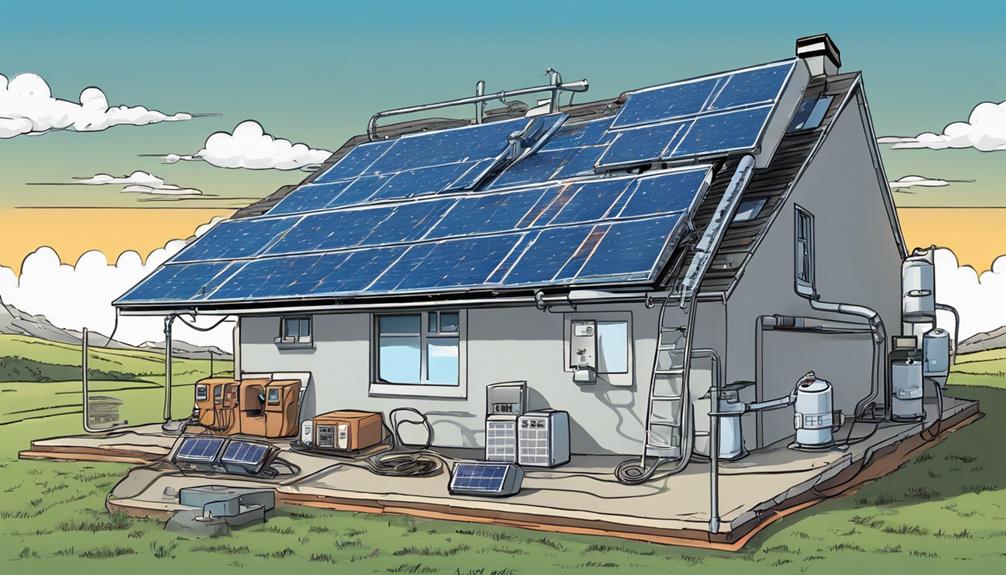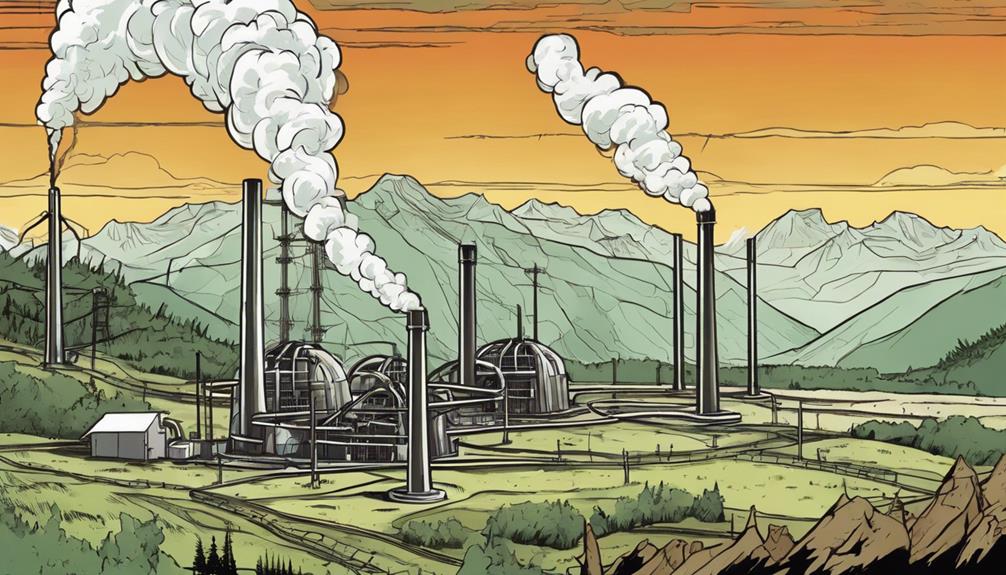You're already taking a critical step towards safeguarding your community from the devastating impact of disasters by considering solar power as a resilient energy solution. Solar energy integration reduces dependence on traditional power sources, enhances energy resilience, and provides a reliable power source during disasters. It also promotes community resilience, reduces greenhouse gas emissions, and supports critical community services. With the right policy and regulatory framework in place, solar power can be an affordable and accessible solution for disaster-prone areas. Now, discover how solar energy can empower your community to take control of its resilience and thrive in the face of adversity.
Key Takeaways
- Solar power strengthens community resilience by providing a reliable energy source during disasters, reducing dependence on traditional power sources.
- Solar energy integration enhances energy resilience, promotes community resilience, and reduces greenhouse gas emissions, contributing to a sustainable future.
- Federal and state incentives, such as tax credits and net metering policies, make solar energy more accessible and affordable for communities.
- Solar-powered microgrids and energy storage systems can seamlessly integrate with the grid, providing stable power supply during extreme weather events.
- By leveraging solar power, communities can take control of their energy needs, foster neighborhood cohesion, and promote environmental stewardship.
Historical Background and Concepts
You've likely heard of solar energy being used in disaster-resilient infrastructure, but did you know that this concept has been around since the 1970s, building upon the development of photovoltaic cells in the 1950s? This innovative approach combines resilient materials with robust energy systems to withstand natural disasters, providing a sustainable and renewable power source. Solar energy converts sunlight into electricity or thermal energy, making it an ideal solution for disaster-resilient infrastructure.
By integrating solar energy, communities can reduce their dependence on traditional power sources, enhance energy reliability, and enjoy cost savings.
As you explore the concept of disaster-resilient infrastructure, understanding the role of solar energy in providing a reliable and sustainable power source is crucial. With technological advancements in solar energy, including high-efficiency solar panels, energy storage systems, microgrids, and smart grid technologies, the possibilities for enhancing disaster resilience are vast.
Benefits of Solar Energy Integration

As you explore the benefits of solar energy integration, you'll find that it offers a multitude of advantages that can greatly enhance disaster resilience.
By integrating solar energy into disaster-resilient infrastructure, you can reduce dependence on traditional power sources, making your community more energy resilient.
High-efficiency solar panels and energy storage systems provide a reliable source of power, even during disasters. This sustainable and renewable source of power enables communities to maintain essential services, promoting community resilience.
In addition, solar energy integration reduces greenhouse gas emissions, contributing to a cleaner environment. The benefits of solar energy are undeniable – it's a cost-effective solution that enhances energy reliability and reduces the burden on traditional power grids.
Policy and Regulatory Framework

As you explore the policy and regulatory framework for solar power in disaster resilience, you'll find that incentives and subsidies play a significant role in promoting the integration of solar energy into disaster-resilient infrastructure.
You'll also discover that building codes and standards are essential in ensuring that solar energy systems are incorporated into infrastructure, making it more resilient.
Incentives and Subsidies
Government-supported incentives and subsidies lessen the financial burden of solar installation, making it more feasible for you to harness the power of the sun. You can benefit from federal tax credits that cover up to 26% of your solar system costs, markedly reducing the upfront expenses.
Additionally, state and local incentives, such as rebates and performance-based incentives, can further lower the financial barrier to installing solar panels. Net metering policies also allow you to receive credit for excess electricity you generate and feed back into the grid, offsetting your energy bills.
These incentives and subsidies play an essential role in promoting the growth of solar energy by making it more affordable and accessible to a wider range of consumers. By taking advantage of these incentives, you can overcome the financial hurdle and reap the benefits of solar power, including reduced energy costs and increased disaster resilience.
With these supportive policies, you can join the growing community of solar adopters and contribute to a more sustainable future.
Building Codes and Standards
You can further solidify your solar-powered disaster resilience by ensuring adherence to building codes and standards that mandate resilient infrastructure and guarantee the safety and performance of your solar energy system during disasters. By following these guidelines and standards, you'll be enhancing your disaster preparedness and response capabilities.
For example, building codes will direct the design and installation of your solar energy system, ensuring it can withstand extreme weather conditions and provide reliable power generation during disasters.
Compliance with building standards and codes is fundamental in ensuring the durability and effectiveness of your solar-powered systems in disaster-prone areas. Regulations and incentives can promote solar adoption, encouraging communities to invest in resilient infrastructure that meets safety and performance requirements. By doing so, you'll be contributing to community resilience against disasters.
Prioritizing building codes and standards is vital to create a robust and reliable solar energy system that can support your community during times of need.
Case Studies and Current Trends

Solar-powered microgrids have proven their worth in disaster-prone areas, with successful implementations like Puerto Rico's Casa Pueblo community serving as a shining example of reliable energy provision. You can learn from these projects and apply their best practices to develop your own disaster-resilient infrastructure.
Some key takeaways from these case studies include:
- Implementation details and outcomes of solar-powered microgrid projects offer valuable insights for disaster-resilient infrastructure, guaranteeing energy security and cost savings.
- Recent trends show increased research focus on energy storage technologies to enhance solar energy integration in disaster response, leading to improved environmental benefits.
- Adoption of solar energy in disaster-prone regions is growing, with more communities investing in solar infrastructure for resilience, making them less vulnerable to natural disasters.
These case studies and trends demonstrate the effectiveness of solar energy systems in providing reliable energy in disaster-prone regions. As you consider implementing solar-powered microgrids in your community, keep these success stories and emerging trends in mind to secure a resilient and sustainable energy future.
Challenges and Future Outlook

As you explore the potential of solar power in disaster resilience, you'll encounter two significant hurdles: technical hurdles and financial barriers.
You'll need to overcome these challenges to harness the full potential of solar energy in disaster-resilient infrastructure.
Overcoming Technical Hurdles
Despite the numerous benefits of solar power in disaster resilience, several technical hurdles must be overcome to promote widespread adoption and effective implementation.
As you consider integrating solar power into your community's disaster-resilient infrastructure, you'll need to address these challenges head-on.
To overcome these hurdles, you can leverage advancements in high-efficiency solar panels to maximize energy generation, energy storage systems to guarantee a stable power supply during outages, and microgrid technologies and smart grid solutions to enable seamless grid integration.
Addressing Financial Barriers
You'll need to tackle financial barriers head-on, as the high upfront costs of equipment and installation can be a significant obstacle to integrating solar power into your community's disaster-resilient infrastructure. However, there are ways to overcome these financial hurdles.
Incentives like tax credits and rebates can help offset the initial expenses for solar energy systems, making them more affordable. You can also explore financing options such as solar loans, leases, and power purchase agreements to make solar power more accessible.
Innovative financing models like community solar and green bonds are emerging to address financial barriers. Community solar programs allow multiple individuals or organizations to share the benefits of a single solar array, making it more affordable. Green bonds, specifically designed for environmentally friendly projects, can provide a new source of funding for solar initiatives.
As the cost of solar power continues to decrease, financial incentives are becoming more attractive, driving adoption and increasing affordability. By leveraging these options, you can make solar power a more viable choice for your community, ultimately strengthening its disaster resilience.
Solar Energy for Community Resilience

By integrating solar energy into their infrastructure, communities can fortify their resilience against disasters and guarantee essential services remain operational during extreme weather events. This is especially important in disaster-prone areas, where solar energy technologies can provide reliable power and improve resilience.
As you consider incorporating solar energy into your community's infrastructure, here are a few key benefits to keep in mind:
- Solar-powered infrastructure supports critical community services: During extreme weather events, solar generation can ensure that essential services like hospitals, emergency response centers, and communication networks remain operational.
- Renewable energy enhances community resilience: By reducing reliance on traditional energy sources, solar energy can help communities withstand disruptions and guarantee essential services remain operational.
- Solar energy empowers communities to take control: By investing in solar panels and energy, communities can take a proactive approach to disaster resilience, rather than simply reacting to disasters as they occur.
Empowering Communities Through Solar

As communities harness the power of solar energy, they're not only building resilience against disasters but also accessing a range of benefits that empower them to thrive in the long term.
By installing solar power systems, you're providing reliable energy sources that can continue to function even when the grid goes down. This helps build community trust and supports critical services during disasters.
Additionally, solar installations can stimulate local economies, creating job opportunities and supporting local solar installation companies. As a result, homes with solar panels not only sell faster and at higher prices but also enhance property values, attracting buyers interested in sustainability.
By embracing the potential of solar energy, you're contributing to a more sustainable and resilient community. Solar power fosters neighborhood cohesion, inspires environmental stewardship, and helps communities become more self-sufficient.
Frequently Asked Questions
How Can Solar Energy Help the Community?
You're wondering how solar energy can help the community? Well, it provides reliable power during disasters, supports critical services, and aids in recovery efforts, ultimately increasing community resilience and reducing energy costs.
Is There a Downside to Community Solar?
You're considering community solar, but you're aware there's a flip side. Yes, there are downsides: siting issues, financing hurdles, and high upfront costs can limit accessibility, making it tough for low-income residents or communities to participate.
Can Solar Panels Withstand Natural Disasters?
Imagine yourself in the eye of a hurricane, and you'll wonder, can solar panels really withstand natural disasters? Yes, you'll be relieved to know that they're designed to brave the storm, withstanding winds up to 140 miles per hour and more.
How Can a Community Become Disaster Resilient?
You can become disaster resilient by identifying vulnerabilities, creating emergency plans, and investing in infrastructure that'll withstand natural disasters, like flood-resistant buildings and redundant systems, so you're better prepared to respond and recover.
Conclusion
As you stand in the midst of devastation, surrounded by the remnants of a disaster, you realize that the sun still shines bright. And with solar power, you can harness its energy to rebuild and rise stronger.
It's a beacon of hope, illuminating a path towards resilience. By embracing solar energy, you're not just generating power, you're empowering communities to weather the storms and shine brighter than ever before.










